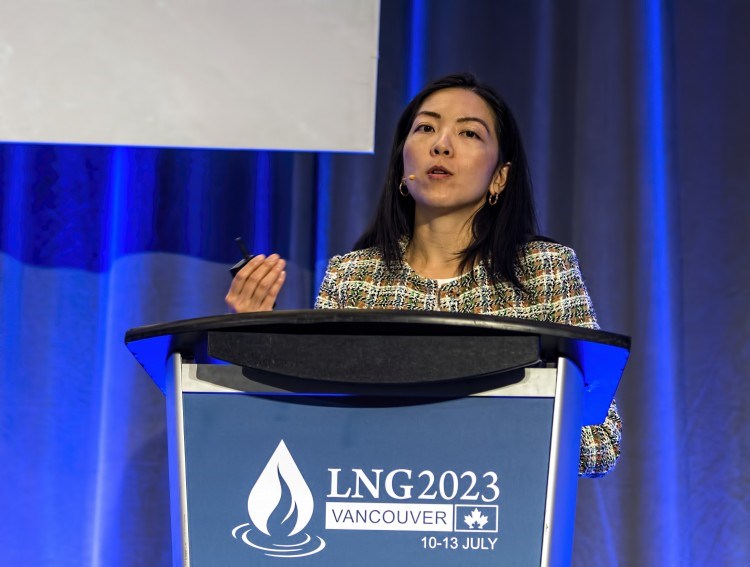When the oil and gas industry claims it can play a critical role in addressing climate change by replacing one fossil fuel with another fossil fuel, it’s understandable that some might suspect some greenwashing is going on.
The David Suzuki Foundation and a group of protesters (Frack Free BC) that staged a “die-in” Monday at the opening of the LNG2023 conference in Vancouver did just that.
“Protesters disrupted the world’s largest LNG convention this morning, as oil and gas CEOs and politicians gathered to greenwash Canada’s fracked gas,” Frack Free BC said in a news release.
“Our marketing campaign pushes back on the LNG greenwashing we’re seeing across B.C.,” the Suzuki Foundation said.
But it’s not greenwashing to state that natural gas produces fewer greenhouse gases than coal does. According to the Intergovernmental Panel on Climate Change (IPCC), gas power produces 50 per cent fewer emissions than coal power, even when methane emissions from natural gas are taken into account.
“Taking into account revised estimates for fugitive methane emissions, recent lifecycle assessments indicate that specific GHG emissions are reduced by one half (on a per-kWh basis) when shifting from the current world-average coal-fired power plant to a modern natural gas combined-cycle (NGCC) power plant,” the IPCC’s Working Group 3 says in its chapter on energy systems.
Of course, natural gas is not nearly as clean as renewable power. But because wind and solar power is intermittent, even those countries that are investing in wind and solar to replace coal power are still going to need some firm backstop for when the wind doesn't blow and the sun doesn't shine.
Natural gas power plants appear to be the ideal lower-carbon peaking solution, since, unlike nuclear power plants, they can be turned on and off relatively quickly in response to fluctuations in power generation from wind and solar.
“It was said to me in no uncertain terms, especially in Asia, that there’s going to be no way for the world to meet carbon emissions reductions without LNG being able to displace the reliance on coal and other higher emitting fuels," Alberta Premier Danielle Smith said Thursday at a keynote address today at the LNG2023 conference.
Although natural gas is already cleaner than coal, the oil and gas industry is working to reduce the GHG emissions intensity of natural gas and LNG even further through three main technology approaches: methane abatement, electrification, and carbon capture and storage (CCS)..
According to one presenter at this week’s LNG2023 conference, had it been available, lower-carbon LNG produced in B.C. could have avoided 600 million tonnes of CO2e between 2020 and 2022, when new coal power plants came online in Asia.
That’s nearly the total GHG inventory for all of Canada in a year – 670 million tonnes (MT) of CO2 equivalent (CO2e).
Some of the upstream in B.C. now runs on electricity, instead of natural gas, and because that electricity comes mainly from clean hydro power, the natural gas being produced in Northeastern B.C. has a comparatively lower emissions intensity.
Moreover, with the exception of LNG Canada, all other LNG projects in B.C. propose to use electric drive, which would further lower the emissions intensity of LNG produced in B.C.
Shell Canada has used both electrification and methane abatement at its Groundbirch operations in Northeastern B.C., which will supply natural gas to the LNG Canada terminal in Kitimat. The Groundbirch operations include 500 natural gas wells and four gas processing plants.
Since 2014, Shell has reduced Groundbirch’s GHG emissions by 30 per cent through electrification and methane abatement, said Mary Lee, safety and sustainability manager for Shell Canada.

By replacing two natural gas turbines with electric ones in 2015, Shell’s Saturn 1 processing plant’s GHG emissions were cut by 90 per cent, Lee said. When it builds its new Saturn 2 plant, it will be fully electric, Lee added.
Of the 72 natural gas processing plants in B.C., 12 are now electrified.
Shell has also reduced its methane intensity at the Groundbirch operations. One way to reduce fugitive methane emissions is by replacing pneumatic valves (which are activated by gas pressure and release methane) with electric actuators. Since 2014, Shell has reduced the Groundbirch operations’ methane intensity by more than 50 per cent, Lee said.
"At Groundbirch...we've demonstrated material progress in reducing our GHG intensity and emissions," Lee said. "This competitive, low-carbon gas supply is super important part of Shell's LNG value chain here in Canada."
In a paper produced by Rockies LNG Partners – a consortium of Alberta natural gas producers who are partners with the Nisga’a First Nation in the Ksi Lisims LNG project – it is estimated that new coal power plants that came online in Asia between 2020 and 2022 generated about 130 gigawatts of power and would have generated about 1.1 billion tonnes of CO2e.
Had Canadian LNG been available to supplant that coal power, the Rockies LNG paper estimated it could have reduced emissions by 600 million tonnes of CO2e.
“Unfortunately, if that had been Canadian LNG, we could have reduced the emissions footprint in that coal-fired power generation by half – 600 million tonnes -- which is just short of the entire CO2 emissions of Canada,” said Rockies LNG CEO Charlotte Raggett. “We could have avoided a Canada’s worth emissions, if we would have had more Canadian LNG on the water.”
In Qatar, LNG produced there is being abated with carbon capture and storage. Qatar Energy has a CCS system that is now sequestering 2 million tonnes of CO2 annually.
“We’re going to go to 11 million tonnes in a few years,” said Saad Sherida Al-Kaabi, Qata’s minister of Energy and CEO of Qatar Energy. “And we’re using solar to power LNG.”
The industry is also hoping to achieve significant GHG reductions by tackling its methane problem.
Methane is magnitudes worse than CO2 in its global warming potential, so reducing methane can have a significant positive impact.
The Oil and Gas Climate Initiative (OGCI) – made up of the world’s 12 largest oil and gas companies, including Royal Dutch Shell (a 40 per cent partner in the LNG Canada project) – has pledged to reduce its methane intensity to near zero by 2030.
In 2018, the OGCI set a target of 0.25 per cent methane intensity by 2025, and its members have already met their target, said OGCI president Julien Perez.
Dealing with methane leakage is not rocket science, Perez said. For the most part, it mainly requires better equipment and better practices to seal leaks in the production, distribution and storage systems. The main challenge has been detecting where the leaks are coming from.
New methane detecting satellites, drones and other technology are giving the industry a better picture of where the methane is leaking so the holes can be plugged.
Since 2017, OGCI companies have reduced absolute methane emissions from their upstream operations by 40 per cent, Perez said.






